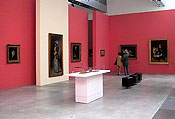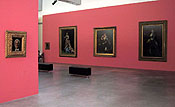The browser will either open the file, download it, or display a dialog.
|
"Carolus-Duran 1837–1917" Annie Scottez-De Wambrechies
|
|||
|
Critical commentary in Carolus-Duran's lifetime was not always generous: in 1903, a Belgian writer called his work "du mauvais gout"; Emile Bernard described him as "cet homme [qui] ne sait ni voir, ni dessiner"; Camille Mauclair thought his work in the line of pictorial "décadence." Because posterity considered him a superficial academic portraitist who compromised his considerable talents for facile financial rewards, his paintings have rarely been studied for themselves. Albert Boime's 1971 examination of the Academy contains but four brief references to the artist, while Robert Rosenblum's and H. W. Janson's 1984 survey of nineteenth-century art, which includes dozens of neglected artists, includes none. With the exception of 155 paintings exhibited as an hommage in 1919 in Paris—the only retrospective of his art to date—it was not until the audacious counter-impressionist show, Équivoques (1973), that his paintings were shown outside of his native Lille. That same year, Michèle le Gal resuscitated his work in a three-volume dissertation that catalogued virtually all of his known paintings. Le Gal's study, supported by the descendents' collection of unpublished works and correspondence, became the impetus that same year for a small exhibition at the Galerie Flavian of thirty-one paintings, but that modest showing, documented only by a checklist, went largely unheralded in the international press. The exhibition The Second Empire (1978) included one painting, while the The Realist Tradition (1981) included two. Clearly, Carolus-Duran's time had not yet come, even in the wave of revisionist nineteenth-century art history that began to consider conservative painters as not so far apart from the more progressive ones. |
|||
| Despite such dismissal from art historians, Carolus-Duran was one of the most sought-after painters of tout Paris in the latter half of the nineteenth century. Like Gérôme, Cabanel, Bonnat, and Bastien-Lepage, his works were constantly in demand and, like them, he made substantial sums in responding to the market, reason enough for some to question the sincerity of his art. Equally important but generally ignored until Barbara Weinberg's study of the Paris training of American painters (1991) was his unique contribution as a teacher, which emerged in 1872 with the establishment of his atelier. The studio became a celebrated alternative to the common academic system, training, among many others, eighty-one American painters, including John Singer Sargent, James Carroll Beckwith, Will H. Low, Kenyon Cox, J. Alden Weir, and Theodore Robinson. What attracted them was Carolus-Duran's unorthodox method of having his élèves draw and paint from the live model simultaneously; in effect, working directly with color and form rather than layering the process through multiple drawing studies as obligatory elements. Will Low did not exaggerate when he described this method as "a radical innovation in the teaching of painting," from which the budding American impressionists developed their unique approach. | |||
| The present exhibition reunites eighty paintings, along with the celebrated portrait of the artist by Sargent and an equally sympathetic depiction by his friend Jean-Jacques Henner. The exhibition covers the entire range of Carolus-Duran's career, from his earliest portrait studies of around 1860 to one of his last notable examples dated 1910. Produced over this fifty-year span, his works show how he absorbed diverse contemporary trends: the early realist paintings drawn from his admiration of Courbet and Spanish painting, whose influence is especially evident in the Le Blessé (often called Le Convalescent) and the Homme endormi (1860–61); diverse landscapes fully in the Barbizon and pre-impressionist modes; and still lifes reflecting his long-standing friendship with Fantin-Latour. The well-written and thoughtfully designed catalogue provides a full accounting, making it the best introduction to his work and providing a complete picture of his artistic achievements. It is carefully prepared with a full bibliography, chronology, and every work of art, including supporting material not in the exhibition, is reproduced in faithful color. | |||
| The first question any historian must ask in contemplating an exhibition of a forgotten painter is whether he is worth reviving. The answer lies always in the taste of the beholder and his or her receptiveness to a balanced picture of the period as incorporating conservative and progressive trends. Glancing even in passing at Carolus-Duran's major works should answer the question quickly. One need only observe the mastery and modernity of his landscapes, lesser known than the portraits, to see that there is reason to look at his work in fresh light. The Promenade sous bois—Forêt de Fontainebleau (1861), a large canvas in Indianapolis that has been exhibited only once before, comes as a surprise in its depiction of a couple in which almost all of the canvas surface is given over to the remarkable wave of foliage and filtered light. In its emphasis on nature rather than the figure, it could easily be compared to Rousseau, but in fact is closer to Monet and more skillful than the latter's work of the same period. So, too, his beach scenes (1869) or his studies of Trouville (1872 and 1875) from private collections; these canvases can be placed solidly in the pre-impressionist camp. His evocative Marine à la barque (1885), recently discovered and not included in Le Gal's dissertation, is an unexpected echo of Courbet and Whistler, rivaling both in poetic associations but standing on its own in mood and technique. And Un soir dans l'Oise, seemingly an ébauche but exhibited as a finished work in 1893 next to two paintings by Burne-Jones, displays, as the critic Yriarte wrote, a remarkable sonority of color and slap-dash brush work that might be mistaken for a work of Moreau or other avant-garde contemporaries (p. 178). | |||
|
|
|||
| While the academic, historical and religious subjects are not successful and sit uncomfortably in his oeuvre, the portraits show Carolus-Duran's true strengths. Many of these are far removed from the static society images one expects to find from consulting the earlier literature. His capacity to capture the essence of his models is astonishing: from the unassuming portrait of the young Astruc (1860) to the candid self-portrait for the Uffizi (1869) and the lilting Dame au gant (1869), these works exhibit an authority and sensitivity to pose and attitude, revealing an adroit and inventive hand. The portrait of the Countess Rattazzi (1872), cousin of Napoleon III and mistress of Eugène Sue, is an extraordinary essay in luxurious paint surface and artistic design. Swathed in a sweeping navy blue dress and adorned with lace and dark pearls, the countess is depicted against an intense red background; this spirited composition demonstrates the artist's innate sense of pictorial harmony. As the exhibition demonstrates, Carolus, like Degas, was also a master of the portrait without fanfare. The one of Étienne Haro (1873), whose right hand beckons as if he is including the spectator in a discourse, is an essay in instantaneous communication. The more doleful portrait of his favorite sister (1875), whose melancholy face is accented by wavy dabbling in washy blue paint, is a prime example of what the critic Jules Claretie called "l'art intime." Standing in front of the portrait of the photographer Nadar in his sixty-sixth year (1886), the spectator can almost converse with one of the most interesting figures of the age. It is hard to find a more candidly improvised rendition than the one he began, but never finished, of Manet (c. 1877), whom Carolus knew and had admired since the late 1850s; Manet, who appreciated Carolus's work, painted a reciprocal portrait that has disappeared. | |||
| These portraits have a flare and originality—as many of Sargent's best portraits have—in terms of color, linear flow, design, free brushwork, and so forth, all of which elevates them above the facile photographic renderings of face and dress. Zola understood this when he labeled Carolus "un élève de la nouvelle école," even though he did not always approve of the painter's more conservative works. But it should be no surprise that Carolus-Duran leaned toward a modernist approach, which remained within his artist framework during his long life. While still in his twenties, the artist was painting en plein air at Chailly-en-Bière well before Bazille, Renoir, or Sisley. It is equally indicative of the painter's liberal views that he presided over the Société Nationale des Beaux-Arts, an institution free of official canons. (This aspect of Carolus's career is the subject of a separate but complimentary exhibition at the Musée d'art et d'industrie André Diligent in nearby Roubaix. The catalogues of these exhibitions are in the process of being published by Gaïte Dignat; three volumes covering up to 1905 have appeared, with a fourth, covering 1906–10, is forthcoming.) It is therefore not inconsistent with Carolus-Duran's views that, when he traveled to New York in 1898, he gave a master class in William Meritt Chase's studio. The portrait he produced in an hour-long demonstration in front of 200 invited guests remained in Chase's collection until his death, an apt reminder that Carolus-Duran's art deserves greater attention, which this fine exhibition and catalogue now amply provides. | |||
| William Hauptman Independent Scholar Lausanne, Switzerland |
|||




